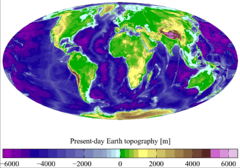Bathymetry facts for kids
Bathymetry is the study of the underwater terrain of lakes or ocean floors. It is the same as topography, except that it looks at the underwater topography. It is a field of oceanography. The name comes from Greek βαθύς (bathus), meaning "deep", and μέτρον (metron), meaning "measure". Bathymetric (or hydrographic) charts are often made to support the safety of underwater navigation and exploration. Most of these underwater topographic maps use contour lines (called depth contours or isobaths) to show the terrain of the sea floor, and how deep it is. They usually also give surface navigational information.
Originally, bathymetry involved the measurement of ocean depth through sounding. Early techniques used heavy rope or cable lowered over a ship's side. This method measures the depth of the water at a single location each time. It was not a very accurate method. The data used to make bathymetric maps today usually comes from an echosounder (sonar). This device is attached to the bottom or the side of a boat.
Images for kids
-
Bathymetry of the ocean floor showing the continental shelves (red) and the mid-ocean ridges (yellow-green) -
The seafloor topography near the Puerto Rico Trench
See also
 In Spanish: Batimetría para niños
In Spanish: Batimetría para niños





